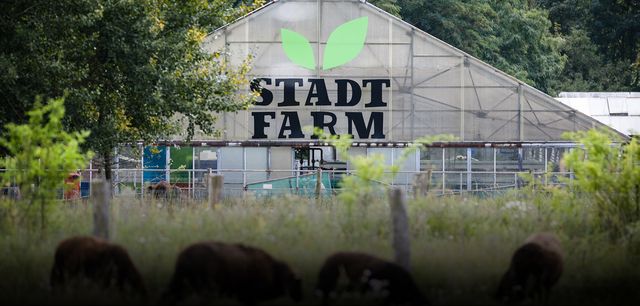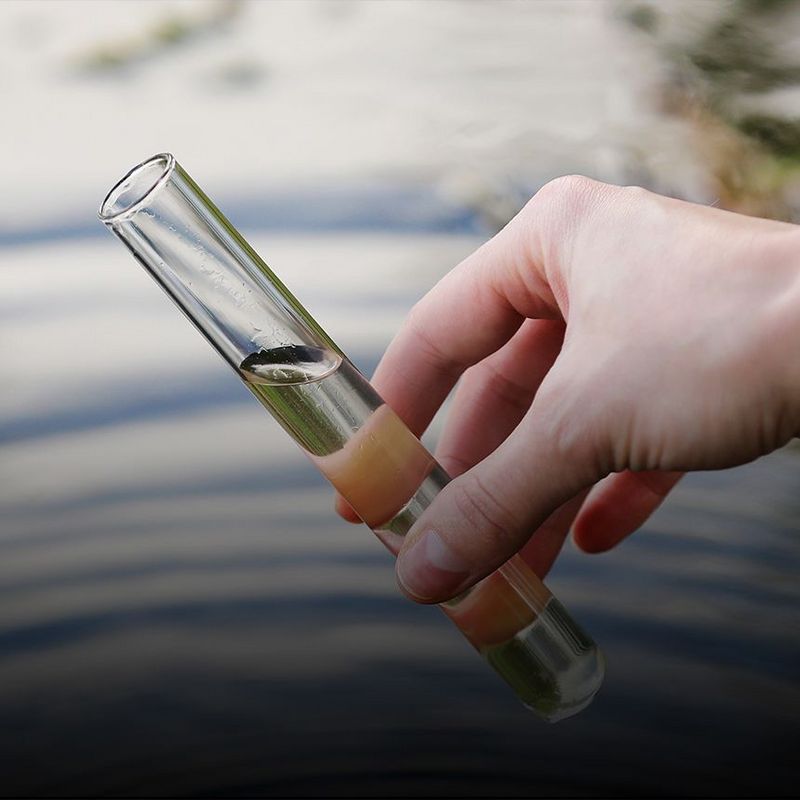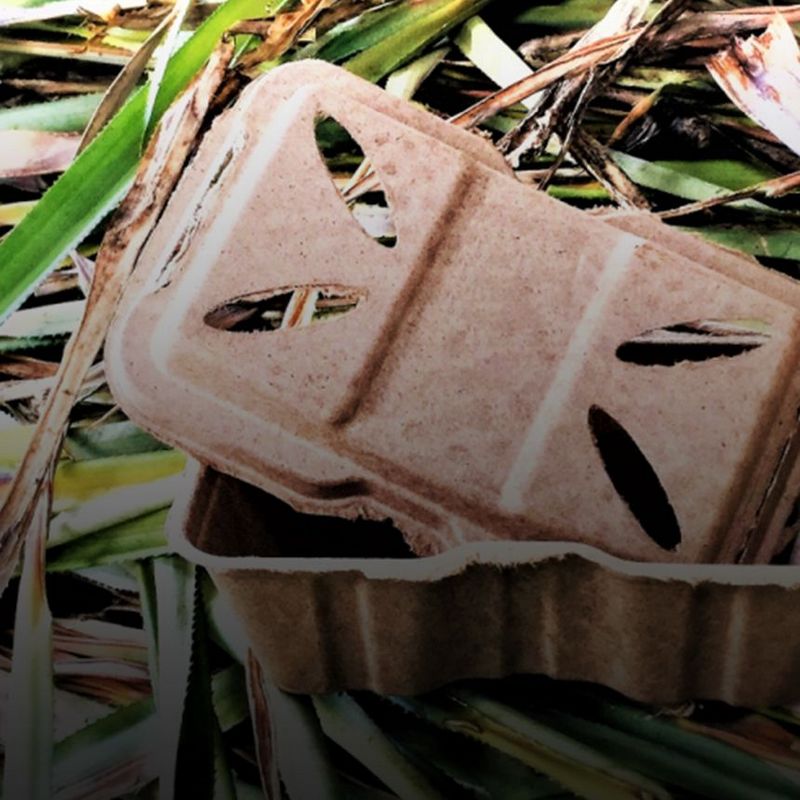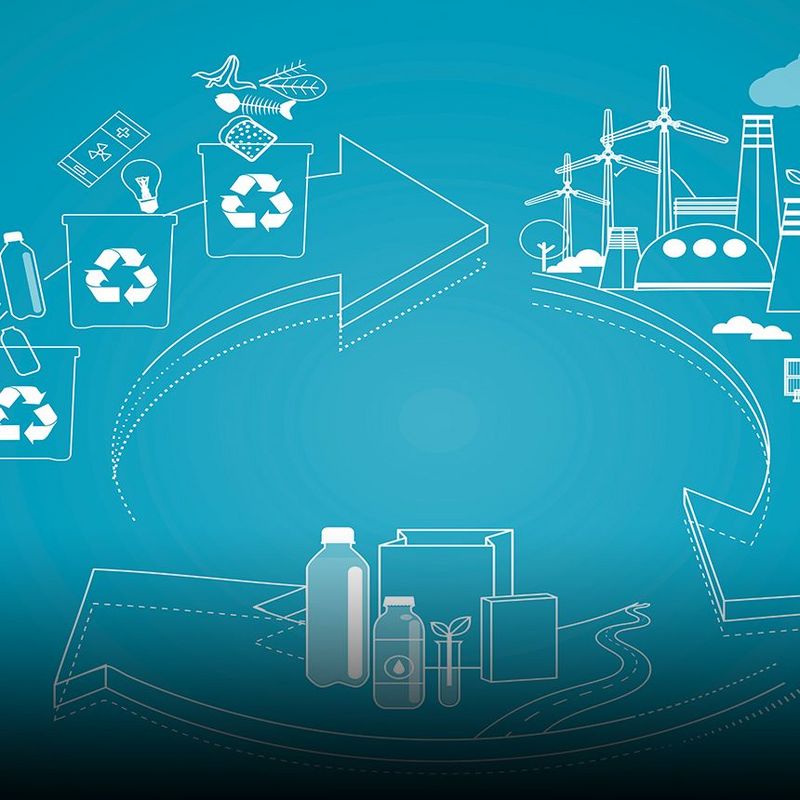04. November 2021
More than half of the world's population now lives in cities. By 2050, this figure is expected to rise to two-thirds. It’s for this reason that innovative companies and initiatives are taking their thinking about regionality one step further: The intention behind Urban Farming and Vertical Farming is to provide people with lettuce, vegetables, herbs and fish while keeping transportation distances to an absolute minimum.
Around you are little birch groves and flowering lilac: if you filter out the prefabricated buildings in the background, being in the Herzberge Landscape Park in Berlin’s Lichtenberg district feels rather like being in Brandenburg. A few Pomeranian sheep are peering through a fence at the greenhouses on the other side of the path. “Stadtfarm” (“Urban Farm”) is written in large letters above the entrance. Until the fall of the Berlin Wall, the state-owned enterprise for horticulture grew gerbera in these greenhouses for export to the West. Basil, parsley and coriander have been cultivated here since 2017 as part of the urban farming programme, and, in the rear part of the hall, tomato plants wind their way upwards. Fertiliser is delivered to them via pipes from large water vats in the greenhouse next door. From time to time, a fish sticks its head up above the water, with long barbels arranged around its open mouth. This is an African predatory catfish. When Anne-Kathrin Kuhlemann throws a handful of food into the water, the pool begins to heave: The surface of the water is whipped up by the fins of countless fish as they race to the surface. Each basin is home to 2,000 cavorting fish, the managing director of the urban farm explains.
© ReinadloCoddouLikes it cosy: The African predatory catfish moves together in a very small space during the dry season. This predestines it for species-appropriate aquaculture.
Programmed for proximity
For Clarias gariepinus, this is not a torment, but part of its genetic programming. When the ponds shrink in the dry season, the predatory catfish cluster together in the smallest of spaces. “This means that living in an aquacultural environment with little space isn’t stressful for our fish. This has also been scientifically proven,” says Kuhlemann. The catfish grow in the vat for about six months without hormones, antibiotics or other medication until they are slaughtered. And they are also recommended as good feed converters for sustainable and species-appropriate aquaculture: One kilogramme of fish food gets converted into almost the same weight of catfish, says urban farmer Kuhlemann. By way of comparison, depending on which study you cite, one kilo of beef can be the end result of the consumption of anything from three to nine kilos of grain.
Clarias gariepinus is rich in protein and omega-3 fatty acids, has hardly any bones and a slightly nutty taste and can be prepared in many ways: filleted, smoked, pickled, or as matjes, bratwurst or fish balls. “A lot of families come every week and tell us that Captain Birdseye is no longer good enough and they now have to pick up fish balls for the kids,” Kuhlemann relates, laughing.
© ReinadloCoddouIn the past, VEB Gartenbau grew cut flowers in the greenhouses for export to the West. Today, tomato plants grow here - fertilised with the excrement of the catfish next door.
From fish droppings to plant fertiliser
But what comes out of a fish’s rear end also has high nutritional value – for the plants in the neighbouring greenhouse. But the fish excrement first has to be made fit for purpose. First of all, the suspended solids are filtered out of the water. They are then directed into the worm filter, where oligochaetes convert them into humus. What remains is water with dissolved nutrients, predominantly ammonium. This is toxic to fish in higher concentrations and can’t be used by plants. Which is why industrious bacteria in a biofilter set about converting it into nitrate. Finally, tomatoes, chili, peppers, lettuce and herbs are supplied with the water, with the addition in winter of chard and kale. The plants extract the nutrients and purify the water in the process, which then flows back into the fish tanks in a suitably purified state.
© ReinadloCoddouThe nutritious water also allows duckweed to grow.
Closed cycle
Aquaponics – the combination of aquaculture and hydroponics, i.e. fish farming and the cultivation of crops in water – is not a new concept. The special thing about the urban farm is that it relies on a process called aquaterraponics. The urban farmers’ plants thrive in the soil, which should in turn enhance nutrient filtration. This renders water exchange superfluous. In classical hydroponic systems, on the one hand, the plants aren’t rooted in the soil, but stand in gutters, where their roots are washed by a nutrient solution. According to Kuhlemann, this simply doesn’t filter out enough nutrients, which is why the water in these systems needs to be exchanged about once a week. Aquaterraponics, on the other hand, uses a closed cycle, as Kuhlemann emphasises: “This makes us the only commercial aquaculture business in the world which doesn’t produce wastewater."
© ReinadloCoddouWater washes around the plant pots eight to ten times a day. Roots and soil absorb the nutrients and clean the water in the process.
When selecting the plants, the emphasis is deliberately on old varieties. “They’re more robust and can cope better with temperature fluctuations than hybrids from the laboratory,” explains Kuhlemann. Pesticides are taboo in the urban farm. Instead, beneficial insects such as lacewing larvae or hatching wasps take care of uninvited guests. This claims to reduce land use by over 80 percent, water use by 90 percent and greenhouse gas emissions by 85 percent compared to conventional agriculture. This vastly reduced carbonfootprint is the result of the absence of artificial fertilisers and much shorter transport routes. “On average, fruit and vegetables travel 1,500 kilometres to get to market; with us it’s just a handful says Kuhlemann. The short distances could also virtually consign food waste to history. Leftover tomatoes are processed into ketchup in the farm’s own kitchen, which is sweetened with home-grown stevia.
© ReinadloCoddouFarm shop in the city: Market day is once a month at the city farm.
A proliferation of urban farms
The urban farm produces 30 tons of vegetables and 50 tons of fish per year. To start with, most of it went to hotels and restaurants. During the first lockdown, sales slumped by 70 percent virtually overnight. The urban farmers now mainly supply private customers. They are currently converting their system to a cooperative agricultural practice. Members pay a fixed fee and receive a monthly share of the vegetables grown. “We can supply 200 people with vegetables and 500 with fish every year,” says Kuhlemann. With over 3.7 million people living in the capital, this is still a small number. But the building permit for the next urban farm in Berlin has already been granted. “We’re working with partners to find suitable sites in Munich and Hamburg,” says Kuhlemann. The business economist is convinced that the potential is there. “Every city has areas that aren’t suitable for house-building; you just have to look for them.” According to optimistic estimates, around ten percent of the dietary needs of the urban population could be covered by urban farms in the long term. The vision is for a thousand urban farms to be set up in Europe, with three to four in each city, the intention being to make the idea both visible and tangible. “We want to show that tomorrow’s solutions are already here. We just have to implement them, and we have to do that consistently.”
© ReinadloCoddouAnne-Kathrin Kuhlemann, co-founder and managing director of Stadtfarm.
Vertical farming – planting upwards
Kuhlemann and her comrades-in-arms aren’t the only ones seeking to supply city dwellers with as much locally sourced food as possible. EFC Farm in Berlin’s Schöneberg district focuses on aquaponics and has been breeding perch and growing basil since 2015. Since then, two further rooftop farms have been built in Switzerland and Belgium. The farm’s main customer, Rewe, has opened a new branch in Wiesbaden this year, on whose roof the EFC farmers are breeding fish and growing herbs. Other start-ups are dispensing completely with horizontal expansion and building upwards. Vertical Farming is the name of the principle to which the start-up Infarm has been committed since 2013. The company grows herbs and lettuce in glass cabinets under artificial light – in the very same supermarkets in which they are sold. The company now claims to be represented in eleven countries and is working with around 30 retailers, including Edeka, Kaufland and Aldi Süd in Germany. Around 1,400 farms have already been installed in supermarkets and distribution centres, where more than 500,000 plants are being harvested every month.
© iStockStacking plants: Because vertical farming builds upwards, significantly more plants can grow in the same space than in the field or in a classic greenhouse.
Digitally driven growth
As well as growing plants in supermarket cabinets, Infarm has also started setting up its own growing centres this year. Their modular design is intended to make it easy for them to be integrated into existing buildings. Each module has a floor area of 25 square metres, extends up to 18 metres in height and should in principle have the same yield as one hectare of arable land. According to the company, compared to traditional agriculture the farms use 95 percent less water, 75 percent less fertiliser, reduce transport requirements by 90 percent and don’t use any pesticides at all.
The growth of the herbs is digitally monitored and controlled via a centralised cloud platform. According to Infarm, this collects more than 50,000 data points on the environmental conditions, growth rate, colour and health of the plants. The yield, quality, taste and nutritional value of plant products could be continuously improved in this way. By 2025, Infarm aims to install growing centres in more than 100 cities in 25 countries and to support conurbations in such a way that their residents can exercise more independent choice in their purchasing of healthy and sustainable food.
© iStockIn the seclusion of the indoor farms, the growth of the plants can be closely monitored and precisely controlled.
High energy costs
“Its unbeatably low water consumption, extremely economical use of space and lack of dependence on location, weather and seasons are without question the great advantages of vertical farming,” stresses Heike Mempel, head of the Applied Science Centre (ASC) for Smart Indoor Farming at the Weihenstephan-Triesdorf University of Applied Sciences. Added to this are the controlled cultivation conditions, which allow plants of consistently high quality to be produced around the clock. The disadvantage of these systems is, however, equally obvious to the researcher: their high level of energy consumption, caused by artificial lighting and air conditioning, which is an economic and ecological burden. “To make the whole thing sustainable, the electricity used should come from renewable sources. We also need intelligent energy concepts,” says Mempel.
Smart methods that research assistant Sabine Wittmann at the institute is looking into. Such as setting the LED lamps to switch on and off several times per second. This would save electricity. And because the lamps also generate less heat, there wouldn’t be the same need to keep the plants cool. The research group is carrying out tests in the institute's own indoor farming container to determine which switching frequency might be possible without slowing down growth. Here, the researchers are also pursuing further approaches to reducing the energy consumption of the new cultivation method.
Into the desert
In terms of price, lettuce, herbs and tomatoes from the plant shelf in the vertical farm can’t yet compete with conventional agriculture, says project manager Mempel. At least not in Europe. In our latitudes, the constantly high level of quality it produces is a very strong argument for indoor farming, which could be used, for example, for the cultivation of medicinal plants. The situation is different in countries such as the United Arab Emirates, which import 95 percent of their food over long distances with massive use of refrigeration. Cultivating vegetables would also pay off here – both economically and ecologically. “If I were to operate indoor farms with solar power there, they would start turning a profit much more quickly,” says Mempel. In general, indoor farming makes it possible to grow plants in regions whose environmental conditions have thus far ruled such cultivation out: in deserts or the eternal ice of Antarctica, for example.
In Europe, however, a change in regulations could also help sell plants grown indoors. Although their cultivation is pesticide-free, they can’t yet be labelled “organic” in the EU because they aren’t grown in natural soil. As far as Mempel is concerned, this exposes the limits of an outdated definition. “In terms of their quality, there’s no good reason why these pesticide-free products shouldn't be considered organic.” In order to make the cultivation conditions transparent for consumers, it might be possible in the future to introduce a distinction between classic-organic and indoor-organic.
A supplement instead of a universal solution
The researcher has no doubt that calorie- or protein-rich foods such as wheat, potatoes, corn and soya will continue to be grown predominantly on conventional farms in the future. “Indoor farming isn’t the ultimate answer to all nutritional issues, but it is an ideal supplement to existing processes,” says Mempel. After all, even though the world’s population is constantly growing, the same can’t be said of agricultural land. More and more people will need to be fed in the future – as healthily and sustainably as possible: And indoor farming will have a key role to play here.”
The difference between urban farming and vertical farming
Urban farming is the generic term for cultivation methods in urban or peri-urban areas for the direct supply of food to conurbations. Urban agriculture produces not only herbs or vegetables but also fish using aquaculture, for example. If it isn’t done in greenhouses, but indoors under artificial light, it is referred to as indoor farming. If the plants are grown on top of each other on shelves in a space-saving manner, this is known as vertical farming.











